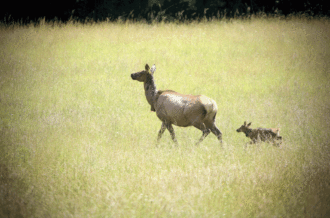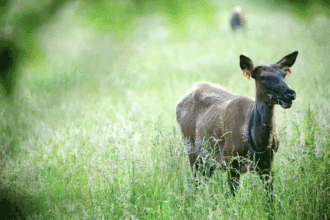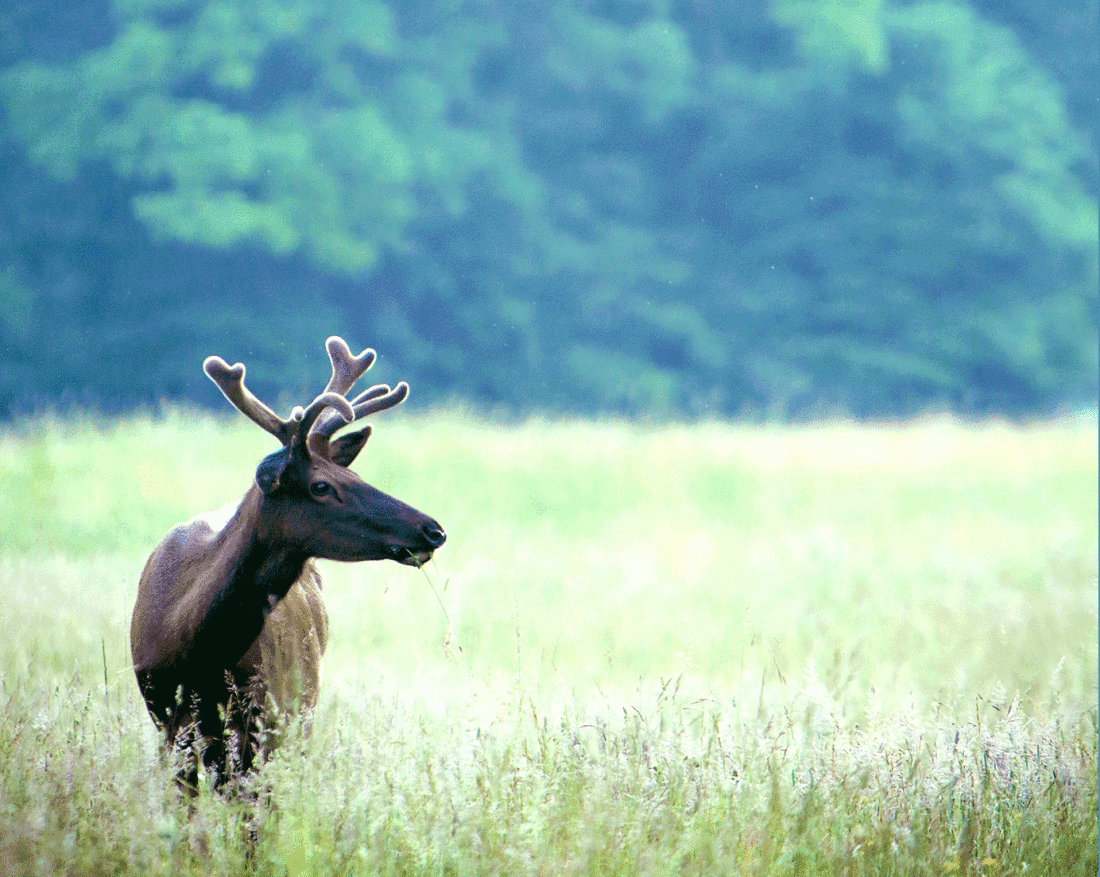By Jack Igelman, originally published by Carolina Public Press. Carolina Public Press is an independent, in-depth and investigative nonprofit news service for North Carolina.
Editor’s note: This article is part 3 of the five-part in-depth series Fraught Forests from Carolina Public Press, which examines the challenges of climate change for Western North Carolina’s mountain forests.
On late fall afternoons, particularly during the mating season known as the “rut,” members of a herd of Manitoban elk reestablished in Great Smoky Mountains National Park assemble and graze in the fields of the park’s scenic Cataloochee Valley.
Along with the elk are throngs of humans reclined in bucket seats, truck beds and camp chairs munching on plates of food to behold the elegant creatures.
The elk-and-tourist juxtaposition can seem strange at first. The herd of wild animals — with their unmistakable bugle and full antler racks — roam freely about as cars carry in lines of visitors packing picnics and portable chairs.
Yet, the edge of the forest in the Cataloochee Valley is just one portion of the herd’s stamping ground. Wildlife, of course, moves where they please for basic needs such as food, water, shelter and finding mates. As a result, as the herd grows, its range expands.
However, climate change coupled with development and human population growth in Western North Carolina has disrupted the ability of wildlife, including elk, American black bears, white-tailed deer, bobcats, red salamanders and others, to traverse their historic ranges.
Land managers and scientists, such as biologist Liz Hillard of the Wildlands Network, are worried about the ability of animals to adapt to warmer climates and disruptive weather events that will likely instigate more movements.
The Wildlands Network’s mission is to use science-based research and policy to prevent biodiversity loss and promote resilience to climate change.
Among the group’s priorities is to conserve core habitats and maintain migration corridors and connected natural areas to improve wildlife’s ability to adapt throughout North America.

“It’s imperative to conserve our biodiverse flora and fauna,” Hillard said. “Connected landscapes will provide wildlife the ability to move and have access to resources in other places.”
Currently, Hillard and three other researchers from the Wildlands Network and the National Parks Conservation Association are examining data gathered from 13 elk equipped with GPS tracking collars to understand how topography is impacting their movements and identify where elk are most likely to cross the interstate highway.
Their focus is a 28-mile section of Interstate 40 that carves through the Pigeon River Gorge dividing Great Smoky Mountains National Park from Pisgah National Forest in North Carolina and Cherokee National Forest in Tennessee.
The Wildlands Network is among nearly two dozen public and private organizations, including the N.C. Wildlife Federation, the National Parks Conservation Association and Defenders of Wildlife, that are partnered in the I-40 Pigeon River Gorge Wildlife Crossing Project.
The Cataloochee Valley, where many elk reside, is roughly 4 miles from I-40.
The federal roadway, Hillard said, is a potential barrier to movement for animals like elk, deer, bears, bobcats and other species. Some species may change their behavior due to the road.
“We have a pretty big responsibility right here in Southern Appalachia and Western North Carolina with our fantastic amount of public lands,” Hillard said.
“It’s a great foundation to work toward building [forest and habitat] connectivity. In the face of climate change, it’s imperative if we want to ensure we have connected landscapes here in Southern Appalachia.”
Once gone, now returned
Elk were once part of the area’s day-to-day landscape, thriving in the Southern Appalachians. But, like many other large grazers roaming here, habitat loss, disease, overhunting and competition from livestock led to their disappearance.
In 1990, the Rocky Mountain Elk Foundation, an organization committed to the future of the animals, proposed that the Smokies reintroduce an elk herd. Bringing them back fit into the Great Smoky Mountains National Park’s mission to preserve native species
Ultimately, officials chose Cataloochee because of its relative isolation, grassy fields and healthy forests. The first 25 elk arrived in February 2001, imported from the Land Between the Lakes National Recreation Area on the Kentucky-Tennessee border after initially being relocated from Alberta, Canada.
Another 27 animals were added in 2002. Although there are several subspecies of elk, the ones that once roamed the Southern Appalachians are now extinct.
The N.C. Wildlife Resources Commission estimates the Cataloochee herd is roughly 225 individuals.
Climate change, however, threatens to reduce habitat availability and is an existential threat to the herd.
Higher average temperatures across the Eastern United States will force some species that rely on colder climates to move northward to counter the effects of warming temperatures.
That population shift may seem more abstract since it will likely happen in slow motion as temperatures change in small increments across a large landscape, Hillard said.
However, the increased severity of weather disturbances such as extreme or catastrophic weather — including major snow and rain events, wildfire, wind, insect outbreaks, disease, flooding, landslides or more persistent droughts — may have a more immediate impact on wildlife that depend on a healthy, forested habitat.
For example, more extreme and volatile weather patterns can impact the success or failure of forest crops, such as acorns. Hillard said research has demonstrated that black bears may undertake extensive movements to find food leading to more interactions with roads and mortality.
“We’re seeing this need for space and having to move farther to find food,” Hillard said.
“The two factors — small incremental changes in temperature or abrupt weather events — increase the risk of local extirpation or extinction.”
In either scenario, some species will need a bigger range and connected habitat to increase their likelihood of success as a species.
But some wildlife populations are more isolated due to forest fragmentation from development, land use patterns and roadways.
“The pinch point is here in the Southern Appalachians,” she said.
And nowhere is that more evident than in the Pigeon River Gorge.
The section of I-40 from Asheville to Knoxville, Tenn., angles on a south-to-north trajectory through the gorge.
To the west is the 522,000 acres of Great Smoky Mountains National Park. To the east are relatively large, unfragmented sections of Pisgah National Forest in North Carolina and Cherokee National Forest in Tennessee.
The two sections of forest unite at a narrow neck like an hourglass, separated by four lanes of concrete running 28 miles from Fines Creek, N.C., to Hartford, Tenn.
Researchers from the University of Washington and the Nature Conservancy modeled potential habitats and plotted movement routes for nearly 3,000 species of mammals, birds and amphibians using climate change projections and climatic needs of the species.
The resulting map shows colorful arrows representing creatures in motion. Species from Central America and Florida merge to form a channel in the Southern Appalachians.
Nikki Robinson, the North Carolina project manager of the Wildlands Network, said her organization has designated three “wild ways” in North Carolina. One of them, along the East Coast, includes a connected network of natural areas that span the Eastern Seaboard.
“We really emphasize the importance of collaboration and communication among state and federal agencies, other nonprofit organizations and the residents of these communities to ensure locally led solutions will support these communities that they’re that we’re serving,” she said.

Yet connecting natural areas, Hillard explained, is a bit like piecing together a jigsaw puzzle.
“These big animals really need to roam and have large home ranges to access resources available at different times of year but also to [respond to] weather events that influence availability of food and habitat,” she said.
The elk movement study is part of a comprehensive examination conducted in the Pigeon River Gorge that was designed to better understand animal behavior patterns in order to pinpoint wildlife-vehicle collision hot spots. The project collected collision data from law enforcement and weekly surveys to detect “roadkill.” In addition, they used dozens of wildlife cameras along the roadway to monitor existing structures on I-40, such as bridges and culverts.
Those findings will identify where to enhance infrastructure on I-40.
Hillard’s research demonstrated that elk, black bears and deer interact with the roadway. She thinks the road creates a barrier effect for animals but admits that understanding wildlife behavior can be perplexing.
For example, she’s observed animals using the roadway but not crossing it. On the other hand, over three years, she observed female elk boldly crossing the interstate to give birth in the national forest and returning to the national park with their calves.
However, among the meaningful findings of the research is that vehicle collisions are more likely to occur near bridges and culverts. Daily, 26,000 vehicles pass through the gorge.
The extreme topography of the gorge, she said, funnels wildlife to the roadway.
“We’ve put our roadways along the path of least resistance, which is also where wildlife want to move,” she said. “The water, the landscape, the topography shape how these elk move. They like to follow valleys and the paths of least resistance just like humans.”
Estimates say more than 1 million large animals are killed annually in collisions with vehicles in the U.S. Large creatures, however, are not the only animals impacted by I-40: Aquatic animals and amphibians are also a concern.
And, of course, humans are hurt, too.
According to the National Highway Traffic Safety Administration, about 200 die every year in animal-vehicle collisions. The average cost of a deer-car collision is $8,190; elk-vehicle collisions exceed $25,000 per crash, according to a paper from the Western Transportation Institute at Montana State University.
This summer the Wildlands Network will publish a statewide report identifying the top 20 wildlife-vehicle collision hot spots in North Carolina, six of which are in the state’s western counties, despite a lower human population density.
Some existing structures in the gorge seem to help facilitate safe passage for wildlife. For example, lower mortality rates and evidence from cameras suggest animals are using a bridge over Jonathan Creek. Black bears are also passing through three culverts near Groundhog Creek. In addition, the current replacement of a bridge at Harmon Den adopted features to ensure safe passage for wildlife and automobiles.
In those places, Hillard believes, adding fencing or other structures to funnel animals to safe passage is an efficient and relatively low-cost solution to facilitate safe wildlife crossings.
Yet, at the top of Hillard’s wish list are two wildlife overpasses — one in Tennessee; one in North Carolina — like an existing wildlife overpass on I-90 in Washington state.
Essentially, it would be a greenway for wildlife to move above the fray of speeding semis and automobiles.
Bridges, of course, aren’t cheap. But Hillard is hopeful there are future funding opportunities, such as the Bipartisan Infrastructure Law that coincides with the urgency to replace aging bridges and structures along the interstate system.
“We think our project is supported by strong research and data that support where these mitigation opportunities are,” she said.
“I think an iconic structure will represent the importance of what wildlife and connected landscapes mean for us in the region.”



Before you comment
The comments section is here to provide a platform for civil dialogue on the issues we face together as a local community. Xpress is committed to offering this platform for all voices, but when the tone of the discussion gets nasty or strays off topic, we believe many people choose not to participate. Xpress editors are determined to moderate comments to ensure a constructive interchange is maintained. All comments judged not to be in keeping with the spirit of civil discourse will be removed and repeat violators will be banned. See here for our terms of service. Thank you for being part of this effort to promote respectful discussion.